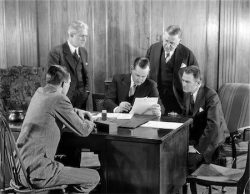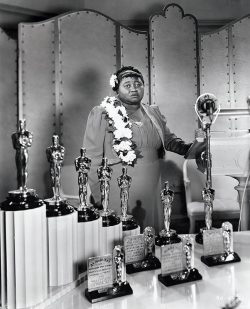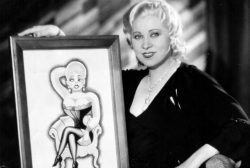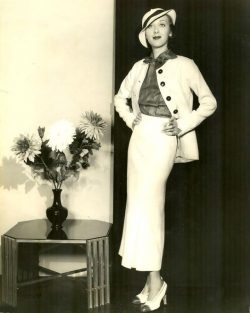“This Is the Action of a Very Naughty Young Lady”

The 1930s Glamour Factory, Fear of Socialist Agitators, and “The Luther of Burbank”
Kerry McElroy writes about pioneering women, including Mae West and Bette Davis, in this third series installment of Bette, Marilyn, and #MeToo: What Studio-Era Actresses Can Teach Us About Economics and Rebellion, Post-Weinstein.
In the previous two essays, we have looked at how everything from migratory patterns to rape trials impacted women’s economic status in the new Hollywood system- and how said women’s status was also informed by American cultural values around economy. An unlikely trip back several decades to an obscure turn-of-the-century economist can be useful in understanding what was so precisely American—and precisely male—about the ascendant Hollywood film industry transmitting its power to the globe.
Thorstein Veblen broke down the cultural imperatives and group psychology that had allowed the cult of new capitalist American manhood to take hold and flourish. Veblen was critical of modernity’s “sign of masculine success [which] was linked to obsession with ‘ownership’ and the competition to gain things whether they are necessary or not” (Brata qtd. in Veblen xvi). Where mainstream writers were celebrating the new American businessman, Veblen identified and clearly drew out, instead, a system predicated on “force, conflict, and power, in which the main players are ruthless predators, not admirable citizens” (Brata qtd. in Veblen xv). It is unsurprising in such a period that a ruthless, winner-take-all business like the Hollywood studio system would have taken hold.
But Veblen is not only useful in reading through early Hollywood as a miasma of sociopathic American machismo capitalism, but the concurrent dominance of women via the billion dollar industry that rehabbed their bodies. As Martha Banta explains in her introduction to Veblen’s seminal The Theory of the Leisure Class:
“One of the more startling aspects of Veblen’s assessment is the stress he places on the male’s “ownership” of women achieved through the retention of entrenched customs. No matter what refinements have been added to contemporary modes of seizure, men continue to appropriate women to affirm their sex’s prerogatives” (Brata qtd. In Veblen xix).
We can thus recognize that the mythos of the dream factory, with its attendant fantasies of beauty, sex, and glamour, was always obscuring a deeply problematic system of finance and power. Many of the same problems being brought to light in the #MeToo, Time’s Up moment, from financial and sexual exploitation to extreme beauty standards, truly took hold in the 1930s when Hollywood was at its most ascendant.

The 1930s is also the time in this series to introduce intersectionality and address the massive elephant of race in the Hollywood room. As the business became more powerful and omnipresent, it became more and more effective at replicating America’s social makeup in terms of race, just as it had in terms of gender. It may seem needless to say that American society of the early twentieth century was completely structurally and interpersonally white supremacist. But this decade saw different levels of opportunity and closed doors in terms of racial hierarchy. Some Latinos and a few Asian-Americans were able to succeed in Hollywood, while black Americans were kept on the most menial rung of the ladder.
There was the rare actress success across racial lines, but always either through total ethnic erasure, as in the exemplary case of Margarita Canseno/Rita Hayworth, or the playing up of exoticism and stereotypes in the case of Los Angeles-born Anna Mae Wong (Leaming; Hodges).
Black women—like all black people attempting to work in Hollywood film—were dealing with something wholly different. Classically trained black actresses were known to be advised that the highest hope for a black actress of appearing on-screen would be to play a maid. Therefore, the savviest career move often was, shockingly, to try to become an actual white star’s maid, in the hopes that one might play her maid on-screen (Bogle). Through such a lens, we have to see the biographies of the few black actresses who became stars in the 1930s, Hattie McDaniel to name one, to be particularly inspirational. These women managed to succeed and maintain their dignity in the face of myriad levels of second class status (Watts).
In terms of economic power or lack thereof for women in Hollywood, it is also a good time to extend an intersectional approach to women in Hollywood in terms of queerness and ethnicity. The vogue for exoticism and foreign born actresses actually led to a positive moment for queerness in terms of both representations of women and economic power. The Dietrichs and Garbos arrived in Hollywood as established European invitees, not American country girls, and their contracts reflected this (Dietrich and Attanasio).
There were, too, a select few American actresses who followed this model—older, established, and business-savvy or with family prestige, sexually free, and thus more able to wield some power both economically and in terms of bodily autonomy. Mae West, though also arriving in Hollywood older and as an undeniable theatre star, became far more of a global phenomenon because while she was dismissive of Hollywood’s falsities, she managed to thrive within it. From her first arrival in Hollywood, she astutely saw through the dream factory glamour mythos so frantically being spun and sold. As West wrote later in her memoir, “the bite of existence did not cut into one in Hollywood, and I watched myself and others and held on to reality” (171).
West saw through the posturing of the moguls, correctly situating them as mostly working class salesmen, far from art and culture, “who had grabbed a good thing and were annoyed that they now had to have writers and actors” (West 152). She had scorn for upstart Los Angeles compared to her native New York City, as when she noted quite clearly, “I’m not a little girl from a little town making good in a big town. I’m a big girl from a big town making good in a little town” (25).
West recognized something key: glamour was no indication of autonomy for women. In fact, it more often served as a regulating, monetizing force. West even recognized her own part in the perpetuation of the glamour-industrial complex, bemoaning women put into the “Mae West model” of makeover and sexifying who didn’t actually have theatre training or acting talent. “I had created a demand for the uninhibited glamour, but I was sorry for the girls being trained like seals for the part… a synthetic star (feminine) was compounded of one part good looks, two parts breastworks, and a world of mad, wild publicity” (West 173).

The top box office draw throughout a good part of the 1930s, West was unlike any other Hollywood star in look, style, frank sexuality, or career control. She refused old-fashioned conventions like “the myth of a woman’s need of male wisdom and protection” (West 53), and saw herself proudly as “an outlaw.” “I didn’t conform or say ‘Yes sir’” (West 159). In this period, West used her business savvy to make herself into an empire, wielding a remarkable amount of power. She didn’t care for some of the arrogant directors and studio heads at Paramount, so she left. She started her own production company, a remarkable feat for the day. In the middle of the Depression, West was making more money than anyone in the U.S., save William Randolph Hearst (West 186). She went to executive meetings and hired her own male co-stars, including a young Cary Grant.
There were other bright spots in women’s finances and actresses winning in the system. Bette Davis lauds Ruth Chatterton in her memoir as an example of a rare 1930s actress superstar deal. As Davis recalled, “In order to win her, Warners had promised her not only eight thousand a week but her choice of stories. It was probably the first fabulous contract for an actress since the innovation of talking pictures” (124).
Conversely, getting out of Hollywood and refusing to play along with such a dehumanizing system for women can also, by our standards, be read as a kind of feminist victory. No actress of the 1930s personified that kind of rebellion specific to the economic focus of this article more than the mostly now-forgotten starlet Ann Dvorak. Dvorak was the rarest of studio actresses, publicly critical of her paltry contract and the economic inequalities for women in such a way that she made a scandal and a scapegoat of herself (Rice). Bette Davis weighed in later in life, noting, “I… understood Ann Dvorak for disappearing from town because an infant in one of her films was earning more money than she” (139).
Fan magazines seized on Dvorak’s remarks on inequality and shrilly painted her as both ungrateful and a socialist. Dvorak was demonized as not being appreciative when so many wanted to be in Hollywood in Depression-impoverished America. Studio Book addressed the actress harshly:
“You, Ann Dvorak, are not yet important enough to get away with it… The motion picture industry is bigger than you are. It can get along without you, but you can’t, excuse me, get along without it. Because no other profession in the world can give you so much” (Rice 96).
In her critique, Dvorak showed a class consciousness that was anathema to the studio heads. Any critique into system inequalities, and from a woman no less, was so unwelcomed as to drum Dvorak out of the business for her insolence.
Still, each article in this series has aimed to take hope in the lives and courage of particular actresses in film history. Bette Davis is arguably the most exemplary of these from the 1930s both for her witty and candid recollections of the exploitative Hollywood underbelly in 1962’s The Lonely Life, and for her role in an important court case over actress rights.
Davis, like West, Bankhead, and Tallulah came to Hollywood with quite a bit of skepticism, snark, and a thriving Broadway career. In Davis’ case, she also arrived on the West Coast equipped with an excellent education and a particularly keen mind. Right from the beginning of her Hollywood journey, Davis connected indignities and shocking improprieties with the signing of the contract. As Davis recalls, “My test was given official approval by Mr. Laemmle and I was offered a contract at three hundred a week with three-month options the first year if the test of my legs proved to be satisfactory….My legs—What had they to do with being an actress?” (101). Davis found much to be desired in the so-called glamour of Hollywood from the beginning, noting wryly, “This was the dizzying depths to which Universal with all its promises had brought me” (110).
Davis found their Hollywood priorities to “sex her up” extremely shallow and distasteful, noting, “When would they all know that I wanted to be an actress, not a glamour girl?” (113). In fact, glamour remained an enemy to craft for Davis from her early career to later decades. She viewed it through a critical feminist lens—as a weapon against female talent and an artifice that stifled art. As Davis noted of her casting in Fashions of 1934, “I was glamorized beyond recognition… Makeup had been given the green light with nary a ‘may I?’” (141). Davis battled with the studio to look real and not glamorous in her deathbed scene in Of Human Bondage, noting indignantly, “the last stages of consumption, poverty, and neglect are not pretty and I intend to be convincing-looking” (Davis qtd. in Sikov 105).

Coming from the East Coast and the theatre world, like West, Davis felt she saw through the bluster and faux-aristocratic airs of the moguls. She noted, “The insecurity of most of these moguls made them wary of a literate group of kids from the theatre” (114). She disdained the executive men as charlatans, feeling that film was meant to become an important art form, and that these salesmen who had wrested power were holding back its potential. Davis characterized her boss Jack Warner as a kind of stern, money-obsessed paterfamilias. She described him sarcastically: “He was the father. The power. The glory. And he was in business to make money” (149). Davis felt that the executives’ lack of expertise or artistry led to their Fordist approach to cinema, wryly noting, “creative artists are not capping soda bottles ninety a minute on an assembly line” (177).
Davis’s battles in Depression-era Hollywood were, like those of other actresses, informed by the poverty and fear of the decade. Davis recognized that because of such widespread economic precarity, studios expected compliance. “They were all used to actors who were grateful they had been rescued from diners or under wet stones and, as long as the cash rolled in, were happy,” Davis remarked (148). The more that Davis showed her intellect and knowledge, the more she made herself an enemy as a woman in the system. “There isn’t the slightest doubt in my mind that they resented my background and my assurance. They were used to empty passive slates they could scribble on” (Davis 136). But where most were in fact docile and compliant, Davis was combative and quarrelsome, until finally she became known as “the Luther of Burbank” (159). Like Dvorak before her, the press spun her actions as those of a greedy, arrogant, and spoiled woman.
Davis had lifelong battles with Warner around salary. She began one rebellion refusing to be in an inane film, and enacted a sort of one-woman strike—for which she received a three month suspension without pay. Following this, the real sticking point proved to be on the subject of contracts and suspensions, as Davis developed a true understanding of what actor contracts and power relations in Hollywood meant. She wrote in later life:
“The very contract system….One had bed and board in jail. I had not one whit of freedom as an artist. The privilege of choice had not been mine for years….I was beginning to feel like an assembly-line actress” (157).
Davis realized what the three month extension actually meant:
“My contract had five more years to run. The time of my suspension would be added to this bondage. In other words, unlike all other forms of employment, the right to strike was not ours. Refusal to pay us was theirs; and these unpaid months would be added to the original contract. Such a contract could be for a lifetime under this incredible arrangement” (166).
Because it is the studio’s right to keep tacking on suspension time, Davis concluded, “It is therefore not a legal contract but a life sentence” (158).
Davis made many strong points on what such a contract meant to an actor’s very personhood:
“If they are forces as punishment not to work and therefore eventually to starve- that is the question of slavery. I suggest that the essence of slavery is not that it is less slavery because the bars are gilded, but because some authority says, “You must continue to work under contract” (166).
This growing economic consciousness and anger led to a remarkable moment for women in Hollywood history: Davis’s 1937 watershed trial in England. The case demonstrated not only the economic exploitation of actresses, but the misogynist logic used to uphold it. Davis went to England to make two films, but refused to perform one of the roles. At this news, Warner dug in and said he would take her to English court. Explaining how the trial came about, Davis later wrote:
“The refreshed thought that I could be forced into putting on a grass skirt and doing a hula if it so pleased my masters and even sent out on personal-appearance tours in that condition so enraged me that when I heard Warner was serious enough to bring this to the English courts and litigation could cost me a fortune, I still refused to turn back. Once and for all I had to consolidate my position as an actress and not a painted puppet subject to my masters’ whims” (161).
Via her contract, even a photo taken of her by her husband at home could be considered an “appearance.” David once noted, “ “I could, by contract, not even arrange to get up a party for my favorite charity….I was absolutely owned by Warners and under their aegis, I could be ordered to dance in a chorus line and forced to comply” (167).
As with the Arbuckle trial, it was obvious that this trial was not about an individual performer but the whole Hollywood system. Davis’s case, in particular, threatened this system to its core, and thus, in the minds of executives, the trial needed to be won and order restored. Actresses could not be allowed to make decisions freely (or, worse, simply quit) or else a whole picture could be wasted. Davis was painted as ungrateful and greedy. The English prosecutor took a highly patronizing tone throughout, declaring, “This is the action of a very naughty young lady” (162).

The prosecutors brought in British mogul Alexander Korda to testify on behalf of Warners. As Davis recalled:
“Mr. Korda…announced that actresses were usually willing to be bought, sold, lent and completely managed by producers because it was usually to their advantage….Mr. Korda admitted further that I worked terribly hard for a woman but “she’s well paid for it.” The attendant smirk was meant to imply that that justified everything” (165).
What might we expect happened to a studio actress and star with such a radical and ahead-of-her-time position in 1937? Davis lost big. She had to pay her lawyer and was ordered to pay all Warners’ costs as well. In a particular flourish of the paternalistic owner, Warner waived the fees and welcomed the “naughty girl” back to Hollywood. Davis was well-aware of the ramifications of her quixotic gambit. “Gaumont British had a big party to celebrate my defeat. If I had won, all their castles would have tumbled” (168). The fear raised by this trial in the studios in matters of workers’ rights cannot be overstated. Davis lost the battle, but she paved the way for another actress, Olivia De Havilland, to win the war a few years later—a point of pride for Davis in her own 1962 memoir (170).
In addition to De Havilland’s crucial and winning court battle, the next article will delve into the changing state of affairs for actresses in the 1940s. As we’ve seen throughout this series, film history offers unexpected success stories for female actresses and true tragedies of exploitation. In the essay that follows, we’ll look at the increasingly sophisticated tactics various actresses employed to avoid “the casting couch” and make their own careers. Finally, we’ll examine how two intellectuals, both women, began to theorize gender and economy in 1940s Hollywood.
References
Bogle, Donald. Bright Boulevards, Bold Dreams: The Story of Black Hollywood. New York: One World Ballantine, 2005.
Davis, Bette. The Lonely Life. New York; Putnam’s, 1962.
Dietrich, Marlene, and Salvator Attanasio. Marlene. Avon, 1990.
Hodges, Graham Russell Gao. Anna May Wong: From Laundryman’s Daughter to Hollywood Legend. Hong Kong; 2012.
Leaming, Barbara. If This Was Happiness: A Biography of Rita Hayworth. Viking; New York: 1989.
Rice, Christina. Ann Dvorak: Hollywood’s Forgotten Rebel. Lexington; Kentucky: 2013.
Sikov, Ed. Dark Victory: The Life of Bette Davis. New York: Holt, 2008.
Veblen, Thorstein, and Martha Banta. Theory of the Leisure Class. Oxford; 2007.
Watts, Jill. Hattie McDaniel: Black Ambition, White Hollywood. New York: Amistad, 2005.
West, Mae. Goodness Had Nothing to Do with It: The Autobiography of Mae West. Englewood Cliffs, NJ: Prentice-Hall, 1959.
Regions: Los Angeles
